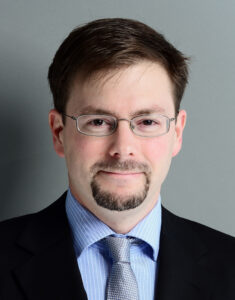
Dr Hoffmann presenterade Chordate Medicals resultat i USA
Chordate Medicals kliniska studie PM007 visar Kinetic Oscillation Stimulation är ett effektivt och säkert behandlingsalternativ för förebyggande behandling av kronisk migrän. Dr Jan Hoffmann, studiens huvudprövare, presenterade nyligen de primära resultaten på American Headache Society Scientific Meeting. Dessutom har en fallbeskrivning presenterats vid en kongress i Berlin som visar lovande behandlingsresultat för en 45-årig kvinna från studien. BioStock pratade med Dr. Hoffmann om hans erfarenheter av studien och K.O.S-behandlingen.
Chordate Medical har utvecklat Kinetic Oscillation Stimulation (K.O.S), en neuromodulerande och läkemedelsfri behandlingsteknologi för kronisk migrän och kronisk nästäppa (rinit). K.O.S är en medicinteknisk produkt som placeras i patientens näshåla, där den framkallar en autonom reaktion genom vibrationer.
Förra året slutförde Chordate Medical en studie (PM007) på migränpatienter som visade att K.O.S signifikant minskar antalet huvudvärksdagar per månad (MHD) med måttlig till svår intensitet. I juni presenterades resultaten vid två kongresser – American Headache Society Scientific Meeting och The German Migraine and Headache Society’s congress.
Presentation vid American Headache Society Scientific Meeting
Den 17 juni presenterade dr Jan Hoffmann från King’s College London vid det årliga vetenskapliga mötet för American Headache Society. Detta är den största vetenskapliga konferensen i USA för vårdpersonal och forskare specialiserade på huvudvärkssjukdomar. Årets upplaga av mötet arrangerades i Austin, Texas, och besöktes främst av specialister från USA, men även internationella experter.
Dr Hoffmanns föreläsning besöktes av cirka 300 migränspecialister. Vd Anders Weilandt deltog också på kongressen för att träffa branschspecialister och forskare. Enligt honom mottogs Dr. Hoffmanns presentation med stort intresse, att döma av de efterföljande frågorna från publiken.
Fallbeskrivning presenterades i Berlin
Dessutom har studiens medförfattare Dr. Charly Gaul presenterat studieresultaten vid The German Migraine and Headache Society kongress i Berlin den 30 juni. Dr Tim P. Jürgens medverkade också för att presentera en fallbeskrivning författad av dr Florian Rimmele. Fallbeskrivningen redogör för en av patienterna i studien, en 45-årig kvinna som under en lång tid har lidit av kronisk migrän med visuell aura.
I hennes fall kunde den vanligaste förebyggande medicineringen inte användas på grund av systemisk mastocytos och andra medicinska tillstånd. K.O.S visade sig vara väl tolererad och långvarigt profylaktisk för patienten. Hennes antal dagar per månad med migrän minskade avsevärt, från 18 till 8 dagar per månad. Den positiva effekten av K.O.S.-behandlingen varade i fyra månader utan ytterligare behandlingstillfällen. Läs fallbeskrivningen här.
Studieresultaten i detalj
Den kliniska studien PM007 genomfördes för att utvärdera effekten av intranasal behandling med K.O.S för förebyggande behandling av kronisk migrän. 132 patienter med kronisk migrän fick antingen intranasal stimulering med K.O.S (85 Hz, 80 mbar) eller skenstimulering (ingen vibration) en gång per vecka i 10 minuter per näsborre under 6 veckor.
De patienter som fick aktiv K.O.S-behandling fick en genomsnittlig minskning på 3,5 migrändagar/månad. Antalet huvudvärksdagar minskade med ungefär lika många dagar under observationsperioden, vilket betyder att man såg en ihållande behandlingseffekt under 4-veckors uppföljningsperioden. Den aktiva behandlingsgruppen hade signifikant bättre resultat jämfört med skengruppen avseende både migrän- och huvudvärksdagar. Studien visade också att behandlingen tolereras väl utan allvarliga biverkningar, vilket indikerar en gynnsam biverkningsprofil.

Intervju med Dr Hoffmann
BioStock kontaktade dr Hoffmann för att få veta mer om resultaten från PM007-studien.
First of all, why do we need alternatives and complements to today’s treatments for chronic migraine?
– Despite having a range of effective treatment options for chronic migraine there is still a significant unmet need for patients with migraine.
– The main reasons for this unmet need are the facts that all currently available preventives are only effective in a certain percentage of migraine patients, they frequently cause significant side effects that can have an important additional impact on the quality of life, and the problem that some of these medications are contraindicated in the presence of some of the most common comorbidities such as for example depression. In particular because of the potential side effects and negative past experience with systemic preventive treatments, patients with migraine are frequently interested in non-pharmacological treatment alternatives.
»Despite having a range of effective treatment options for chronic migraine there is still a significant unmet need for patients with migraine. […] Patients with migraine are frequently interested in non-pharmacological treatment alternatives.«
What were the most interesting findings in the PM007 clinical trial with K.O.S according to you?
– Aside of the clinical efficacy, in my opinion the two most interesting findings are the sustained treatment effect throughout the follow-up period and the favourable side effect profile.
Could you explain how K.O.S affects the autonomic nervous system and reduces the number of headache days?
– We do not yet understand in detail the exact mechanisms underlying the treatment effect of K.O.S in chronic migraine. However, as kinetic oscillation of the nasal cavity elicits trigeminal cranial autonomic symptoms such as lacrimation (tear-flow), given the preclinical and clinical evidence that modulation of the parasympathetic outflow which mediates these symptoms can be favourable in the context of migraine, and the anatomical proximity to the relevant structures such as the sphenopalatine ganglion, it seems likely that K.O.S may act by influencing the parasympathetic outflow thereby modulating the so-called trigemino-autonomic reflex which in turn could lead to the observed reduction in headache frequency.
What were the overall reactions and thoughts on K.O.S at the congress?
– In general, the audience was very interested in the findings which was reflected in the questions and discussions that followed the presentation. For the attendees, the findings were of great interest as K.O.S is based on an entirely new and non-pharmacological treatment concept. In addition, in contrast to some of the other available neuromodulation techniques, the efficacy of K.O.S was demonstrated by a sham-controlled trial and not just by an open-label study. In this context, considering the non-pharmacological nature of the treatment and the unmet need from a patients’ perspective, K.O.S clearly raised a significant interest among attending clinicians.
»For the attendees, the findings were of great interest as K.O.S is based on an entirely new and non-pharmacological treatment concept. In addition, in contrast to some of the other available neuromodulation techniques, the efficacy of K.O.S was demonstrated by a sham-controlled trial and not just by an open-label study.«
In addition, a recently presented case study demonstrates the potential of K.O.S in patients who, for various reasons, cannot medicate with drugs typically prescribed for chronic migraines. Why is K.O.S a valuable treatment for this kind of patient?
– Because of its non-pharmacological mechanism and the resulting favourable side effect profile, K.O.S provides an alternative for patients for which other treatments were ineffective or not tolerated as well as for patients who prefer a non-pharmacological treatment approach. The reported patient reflects this situation and highlights the importance of both the current unmet need and the positive impact K.O.S can have on a patient’s quality of life.
Innehållet i BioStocks nyheter och analyser är oberoende men BioStocks verksamhet är i viss mån finansierad av bolag i branschen. Detta inlägg avser ett bolag som BioStock erhållit finansiering från.
